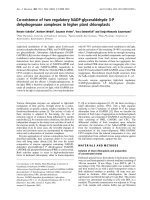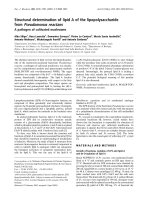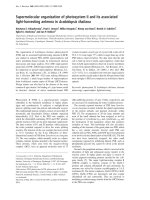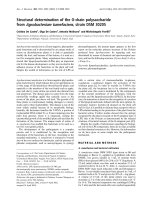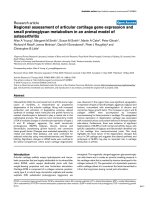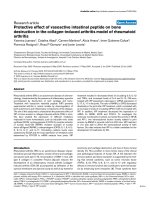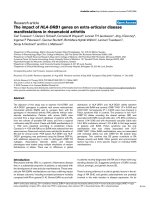Báo cáo y học: "Serial determination of cyclic citrullinated peptide autoantibodies predicted five-year radiological outcomes in a prospective cohort of patients with early rheumatoid arthritis" ppt
Bạn đang xem bản rút gọn của tài liệu. Xem và tải ngay bản đầy đủ của tài liệu tại đây (568.88 KB, 8 trang )
Open Access
Available online />Page 1 of 8
(page number not for citation purposes)
Vol 8 No 2
Research article
Serial determination of cyclic citrullinated peptide autoantibodies
predicted five-year radiological outcomes in a prospective cohort
of patients with early rheumatoid arthritis
Olivier Meyer
1
, Pascale Nicaise-Roland
2
, Marie dos Santos
2
, Colette Labarre
2
,
Maxime Dougados
3
, Philippe Goupille
4
, Alain Cantagrel
5
, Jean Sibilia
6
and Bernard Combe
7
1
Rheumatology Unit, Assistance Publique Hôpitaux de Paris, Bichat University Hospital, 75018 Paris, France
2
Biological Immunology Department, Assistance Publique Hôpitaux de Paris, Bichat University Hospital, 75018 Paris, France
3
Rheumatology Unit B, Assistance Publique Hôpitaux de Paris, Cochin University Hospital, 75014 Paris, France
4
Rheumatology Unit, Trousseau University Hospital, 37044 Tours Cedex 1, France
5
Rheumatology Unit, Rangueil University Hospital, 31043 Toulouse Cedex 4, France
6
Rheumatology Unit, Hautepierre University Hospital, 67098 Strasbourg Cedex, France
7
Rheumatology Unit, Lapeyronie University Hospital, 34296 Montpellier Cedex 5, France
Corresponding author: Olivier Meyer,
Received: 16 Sep 2005 Revisions requested: 10 Oct 2005 Revisions received: 12 Dec 2005 Accepted: 4 Jan 2006 Published: 26 Jan 2006
Arthritis Research & Therapy 2006, 8:R40 (doi:10.1186/ar1896)
This article is online at: />© 2006 Meyer et al.; licensee BioMed Central Ltd.
This is an open access article distributed under the terms of the Creative Commons Attribution License ( />),
which permits unrestricted use, distribution, and reproduction in any medium, provided the original work is properly cited.
Abstract
The objective of this study was to evaluate the potential of
serially determined anti-cyclic citrullinated peptide (CCP)
antibodies for predicting structural joint damage in patients with
early rheumatoid arthritis (RA), compared to a single baseline
determination. Ninety-nine RA patients with disease durations of
less than one year and no history of disease-modifying
antirheumatic drug therapy were followed prospectively for at
least five years. Anti-CCP2 concentrations were measured
using a second-generation ELISA. Sharp scores as modified by
van der Heijde were determined on hand and foot radiographs.
Anti-CCP2 antibodies were detected in 55.5% of patients at
baseline and 63.6% at any time during the first three years.
Presence of anti-CCP2 at any time during the first three years
was associated with radiographic damage at baseline (odds
ratio (OR), 3.66; 95% confidence interval (95% CI) 0.99–
13.54) and with five year progression of the total Sharp score
(OR, 3.17; 95% CI, 1.3–7.7), erosion score (OR, 5.3; 95% CI,
1.4–19.2) and joint space narrowing score (OR, 2.8; 95% CI,
1.15–6.8). The presence of anti-CCP2 or IgM RF at baseline did
not predict these outcomes. Patients with negative anti-CCP2
tests throughout follow-up had less radiographic progression
than patients with increasing anti-CCP2 concentrations; they
did not differ from patients with decreasing anti-CCP2 antibody
levels. HLADRB1* typing showed that progression of the mean
modified Sharp score was not correlated with the presence of
the shared epitope alleles. In conclusion, serially determined
anti-CCP2 antibodies during the first three years of follow-up
performs better than baseline determination for predicting
radiographic progression in patients with early RA.
Introduction
Autoantibodies to citrullinated cyclic peptides (CCPs) were
recently described as useful diagnostic markers for rheuma-
toid arthritis (RA) [1]. Studies that used the first-generation
ELISA (CCP1) suggested that the presence of anti-CCPs
might predict erosive disease in populations with early RA [2-
7]. Similar results were obtained recently with the second-gen-
eration ELISA (CCP2) [8-10]. However, not all patients with
anti-CCPs go on to experience erosive disease. Anti-CCP2 is
associated with erosions and radiographic progression, but
most of the odds ratios (ORs) reported to date are only mod-
estly elevated, in the 2.5 to 3.5 range. Models combining sev-
eral parameters have been built in an attempt to identify
patients at high risk for severe disease progression. C-reactive
CCP = cyclic citrullinated peptide; CCP1 = first-generation CCP test; CCP2 = second-generation CCP test; CI = confidence interval; DMARD =
disease-modifying anti rheumatic drug; ELISA = enzyme linked immunosorbent assay; IgM M0 = month 0 (baseline); M12 = month 12; M36 = month
36; Mo-Co-To = Montpellier-Cochin-Tours/Toulouse cohort; MTX = methotrexate; OR = odds ratio; RA = rheumatoid arthritis; RF = immunoglobulin
M rheumatoid factor; SE = shared epitope; SSZ = sulfasalazine.
Arthritis Research & Therapy Vol 8 No 2 Meyer et al.
Page 2 of 8
(page number not for citation purposes)
protein combined with anti-CCP was the only significant pre-
dictor of joint destruction in the hands and feet after 10 years
in a cohort of 176 patients with early RA at enrollment [10].
The HLA DR4 shared epitope combined with anti-CCP2 was
the best combination for predicting severe disease progres-
sion in a study of 268 patients with early RA [9]. Thus, anti-
CCP2 is emerging as a key tool for predicting joint damage in
patients with early RA.
We investigated whether the predictive value of anti-CCP2 for
radiographic joint damage in RA could be improved by repeat-
ing the assays over time. To this end, we compared baseline
anti-CCP2 versus serial anti-CCP2 assays throughout the first
three years. Sensitivity and the OR for predicting joint damage
were determined for each strategy.
Materials and methods
Patients
Ninety-nine patients (72 female and 27 male) who met at least
four 1987 American College of Rheumatology criteria for RA
[11] and had disease duration of less than one year were fol-
lowed prospectively for at least five years. Patients were part
of an early-RA cohort (called the Montpellier-Cochin-Tours/
Toulouse (Mo-Co-To) cohort) of 191 patients reported previ-
ously [12]. At enrollment, none of the patients had experience
with disease-modifying antirheumatic drugs (DMARDs). Dur-
ing the first 3 years of follow-up, all but 3 patients received
methotrexate alone (7.5 to 15 mg/week; n = 38), sulfasalazine
alone (2.5 g/day; n = 31), or both drugs in combination (n =
27). Oral corticosteroids (prednisolone, 5 to 15 mg/day) were
received by 33 patients. No patients were treated with biolog-
ical agents.
The study protocol was approved by the appropriate ethics
committee. All the patients signed an informed consent docu-
ment.
Methods
Sera obtained at baseline and after one and three years were
stored at -20°C until use. Anti-CCP2 was assayed using a
commercial ELISA kit (Immunoscan RA mark 2, Eurodiagnos-
tica, Arnhem, The Netherlands) according to the manufac-
turer's instructions. Antibody concentrations are given as a
continuous variable from 25 U/ml to >15,200 U/ml). The
upper limit of normal (cutoff) was 50 U/ml. In addition, immu-
noglobulin M rheumatoid factors (IgM RFs) were assayed
using an in-house ELISA and considered positive when ≥ 20
IU/ml. Patients were classified according to the cutoff value of
the serological tests as IgM RF positive or negative and anti-
CCP2 positive or negative, at baseline and at later time points.
Patients with anti-CCP2 antibodies (n = 63) were further clas-
sified into three groups according to the anti-CCP2 concen-
tration change between baseline and month 36, as follows: no
change, defined as a positive value (>50 U/ml) with a smaller
than 30% variation from baseline (n = 12); decrease, defined
as a greater than 30% drop from baseline (n = 32), including
patients with conversion from positive to negative by the end
of the follow-up; and increase, defined as a greater than 30%
elevation from baseline (n = 19) or conversion from negative
(<50 U/ml) to positive. The 36 other patients had no anti-
CCP2 antibodies at any of the study time points.
Radiographic measurements at the hands and feet were taken
at baseline and after three and five years. Radiographs were
evaluated by two independent observers who were unaware
of the patient data. The observers used the Sharp method as
modified by van der Heijde [13]. For each patient, an erosion
score, a joint space narrowing score, and a total damage
score calculated as the sum of the first two scores were deter-
mined for the hands and feet. At baseline, 19 patients (20%)
had significant structural damage (total Sharp score higher
than 5.5).
To determine a cutoff value above which score changes indi-
cated individual radiographic progression unrelated to meas-
urement error (that is, the smallest detectable difference), we
calculated the mean of the differences between two measure-
ments, as described previously [14]. As recommended by
OMERACT [15], we defined radiographic progression as a
radiographic score change greater than the upper boundary of
the 95% confidence interval (95% CI) of the relevant differ-
ence. After five years, this upper boundary was 4.1, 3.2 and
Table 1
Baseline characteristics in 99 patients with early rheumatoid
arthritis
Female (%) 72
Mean age (years) 50.7
Mean disease duration (months) 4.3
Pain (100 mm VAS) 54.4
Morning stiffness (minutes) 84
Ritchie index 17.8
Tendon joint count 21.8
Swollen joint count 8.4
Nodules (%) 6
ESR (mm/1
st
h) 38.4
CRP (mg/l) 32
IgM RF positive (%) 71
DAS 44 4.1
HLA DRB1*04 (%)
a
53
HLA DRB1*01 (%)
b
15.5
a
DRB1*04 includes DRB1*0401, *0404, *0405, and *0408.
b
DRB1*01 includes DRB1*0101 and *0102. CRP, C-reactive
protein; DAS, disease activity score; ESR, erythrocyte sedimentation
rate; IgM RF, immunoglobulin M rheumatoid factor; VAS, visual
analog scale for pain.
Available online />Page 3 of 8
(page number not for citation purposes)
5.5 for the erosion score, narrowing score and total score,
respectively. Using this definition of radiological progression,
after five years 50 patients had no radiographic progression
and 49 had progression of one or more radiographic scores
(total score, n = 47; erosion score, n = 25; and narrowing
score, n = 45).
HLA DR typing and subtyping were performed by PCR using
specific primers and hybridization with sequence-specific oli-
gonucleotides. DRB1 alleles *0101, *0102, *0401, *0404,
*0405 are prevalent shared epitope (SE) alleles found in our
RA population. The prevalence of the shared epitope in the
control French population is 37.1% [16].
Statistical analysis
The chi-square test was used to examine concordance
between one (baseline) and multiple anti-CCP2 determina-
tions and between IgM RFs at baseline and after three years.
We evaluated the effectiveness of anti-CCP2 and IgM RFs at
baseline and over time for predicting radiographic progression
after five years. Patients were separated into two groups, with
and without radiographic progression. The OR with the 95%
CI for significant radiographic progression was calculated, as
well as the sensitivity and specificity of anti-CCP2 for predict-
ing radiographic progression after five years. The analysis was
then repeated after stratification of patients according to their
anti-CCP2 status during follow-up, as follows: persistent neg-
ative anti-CCP2 test; unchanged anti-CCP2 concentration;
increased anti-CCP2 concentration (with a switch from nega-
tive (<50 U/ml) to positive in 7 of 19 patients); and decreased
anti-CCP2 concentration (with a switch from a positive to a
negative (<50 U/ml) test in 8 of 32 patients).
Figure 1
Anti-CCP2 concentrations at baseline (month 0 (M0)), 1 year (M12) and 3 years (M36) of follow-up according to (a) decreasing concentrations (panel 1 and 2), (b) increasing concentrations (panel 1 and 2) or (c) steady concentrationsAnti-CCP2 concentrations at baseline (month 0 (M0)), 1 year (M12) and 3 years (M36) of follow-up according to (a) decreasing concentrations
(panel 1 and 2), (b) increasing concentrations (panel 1 and 2) or (c) steady concentrations. Patients with transition from positive to negative and
negative to positive are shown on panel 2 in (a, b).
Arthritis Research & Therapy Vol 8 No 2 Meyer et al.
Page 4 of 8
(page number not for citation purposes)
Data were also analyzed with the anti-CCP2 concentration
and the radiographic Sharp score as continuous variables.
The nonparametric Spearman test was used to evaluate cor-
relations linking the progression of the radiographic Sharp
scores to the baseline anti-CCP2 concentration and to the
mean serial anti-CCP2 concentration computed as
∑(M0+M12+M36)/3, where M0 is month 0 (baseline), M12
is month 12 and M36 is month 36.
We tested the hypothesis that patients with persistent or
increasing anti-CCP2 concentrations were more likely to show
radiographic progression than patients with persistently nega-
tive anti-CCP2 tests. We compared more than one anti-CCP2
determination to one determination at baseline for predicting
radiographic progression after five years. The ORs with their
95% CIs were computed. We used the Mann-Whitney test to
compare the erosion, narrowing and total scores across
patients categorized based on anti-CCP2 over time and to
compare anti-CCP2 concentrations in patients with or without
SE alleles. Finally, the chi-square test was used to evaluate the
presence of anti-CCP2 according to the presence of one or
more SE alleles. Differences were considered statistically sig-
nificant when P was smaller than 0.05 and when the 95% CI
did not include 1.
Results
Clinical features and laboratory test results in the 99 patients
with early RA (Table 1) were not different from those in the
entire Mo-Co-To cohort, which have been published else-
where [12].
Sensitivity for RA of a positive anti-CCP2 test in our population
of 99 patients with early RA was 55.5% at baseline and 63.6%
at any time during the first three years of follow-up. In seven
(7%) patients, anti-CCP2 was negative at baseline but con-
verted to positive within the first three years, whereas in 8 (8%)
patients anti-CCP2 was positive at baseline but converted to
negative within the first three years (Figure 1a, b, panel 2).
Among 19 patients with increasing anti-CCP2 concentrations
during the first three years of follow-up, seven were treated
with methotrexate (MTX; 37%), seven with sulfasalazine (SSZ;
37%), and five with both drugs in combination (MTX + SSZ;
26%). Of these 19 patients, seven had no anti-CCP antibod-
ies at baseline and converted to positive during follow-up (2
treated with MTX, 3 with SSZ, and 2 with MTX + SSZ). Among
32 patients with decreasing anti-CCP2 concentrations, 14
were treated with MTX (43.75%), 10 with SSZ (31.25%), 6
with MTX + SSZ, and 1 with hydroxychloroquine; 1 patient
received no DMARDs. Of the 32 patients who were anti-
CCP2 positive at baseline, 8 converted to negative by the end
of the first three years of follow-up (5 treated with MTX, 1 with
SSZ, 1 with MTX + SSZ, and 1 with hydroxychloroquine).
None of the differences in DMARD regimens across these
subgroups was statistically significant. Serum IgM RF was
detected in 73.7% of patients at baseline and in 83.8% at
some time during the first three years. IgM RF titer status
changed within the first three years in 45 patients, of whom 34
converted from positive to negative and 11 from negative to
positive (data not shown).
Significant structural damage was present at baseline in 20
patients and after five years in 59 patients (total Sharp score).
Presence of anti-CCP2 at the first determination was not sig-
nificantly associated with radiographic damage at baseline
(13/55 (23.6%) patients with anti-CCP and 7/44 (15.2%)
patients without anti-CCP; OR, 1.63; 95% CI, 0.59–4.54; P
= not significant).
Presence of anti-CCP2 at any time during the first three years
was associated with radiographic damage at the hands and
feet at baseline (17/63 (27%) patients with anti-CCP and 3/
36 (8.3%) patients without anti-CCP; OR, 3.66; 95% CI,
0.99–13.54; P = 0.063).
To investigate the value of a positive anti-CCP2 test for pre-
dicting radiographic progression, we computed the ORs for
radiographic progression after five years with the serial anti-
CCP2 strategy (Table 2) and we compared the results to
those obtained with anti-CCP2 determination at baseline only.
Table 2 reports the ORs for radiographic progression accord-
ing to serial IgM RF values and to baseline IgM RF status. The
95% CI values showed that presence of anti-CCP2 at any
time during the first three years significantly predicted ero-
sions (P = 0.007), joint space narrowing (P = 0.03), and total
Table 2
Anti-CCP and IgM RF as predictors of radiographic joint destruction after 5 years
Odds ratios (95% confidence intervals)
Erosions Joint space narrowing Total
Anti-CCP2 (baseline) 1.91 (0.73–4.96) 1.64 (0.73–3.68) 1.90 (0.85–4.27)
Anti-CCP2 (first 3 years) 5.28 (1.45–19.2)
a
2.8 (1.15–6.78)
b
3.17 (1.30–7.69)
c
IgM RF (baseline) 0.45 (0.17–1.17) 0.57 (0.23–1.39) 0.67 (0.28–1.65)
IgM RF (first 3 years) 0.70 (0.21–2.25) 1.03 (0.35–3.0) 0.88 (0.30–2.58)
a
P = 0.007;
b
P = 0.03;
c
P = 0.01. IgM RF, immunoglobulin M rheumatoid factor.
Available online />Page 5 of 8
(page number not for citation purposes)
score deterioration (P = 0.01), whereas the presence of anti-
CCP2 detected by a single determination, at baseline, pre-
dicted none of these outcomes.
Figure 1 summarizes the anti-CCP2 antibody level variations
among patients with increasing concentrations and patients
with decreasing concentrations between baseline and month
36. The median antibody level increase (∆ M36 minus M0;
207 U/ml; range, 57 to 1,190) did not differ significantly from
the median antibody level decrease (∆ M0 minus M36; 1003
U/ml; range, 27 to 3,200).
Erosions were noted after five years in 35% (22/63) of
patients with positive anti-CCP2 at any time during the first
three years and in 8.3% (3/36) of patients with negative anti-
CCP2 throughout the first three years (two patients had a tran-
siently and weakly positive anti-CCP2 test at 12 months) (Fig-
ure 1). Among patients with and without anti-CCP2 during the
first three years, 54% (35/65) and 29% (10/34) had joint
space narrowing, respectively, and 57% (37/65) and 29%
(10/34) experienced total score deterioration, respectively.
Figure 3 reports the mean (± standard deviation) changes in
the erosion score, narrowing score and total score after five
years according to anti-CCP2 variations. The mean erosion
score and total score were significantly higher in patients with
increasing anti-CCP2, compared to those with decreasing
antibody levels. Patients with negative anti-CCP2 tests
throughout follow-up had less structural damage (erosions,
narrowing and total score) than did patients with increasing
anti-CCP2 concentrations. Finally, regarding structural deteri-
oration, patients with stable anti-CCP2 concentrations did not
differ from those with increasing or decreasing anti-CCP2 tit-
ers.
We evaluated correlations between the baseline anti-CCP2
antibody level, or the mean of the three anti-CCP2 antibody
levels, and the Sharp score changes after five years (erosion
score, narrowing score and total score) in the 99 patients.
Correlation coefficients for the mean of the three anti-CCP2
concentrations are reported in Table 3. All three radiographic
scores were significantly correlated with the mean serial anti-
CCP2 concentrations, whereas the correlations with the base-
line anti-CCP2 concentration fell slightly short of significance
(Figure 2).
One or two SE alleles (*0401, *0404, *0405, *0101, or
*0102) were found in 68% of patients. This proportion was
higher in patients with than in patients without anti-CCP2
(61% and 50%, respectively), although the difference was not
statistically significant. The mean serial anti-CCP2 concentra-
tions were compared in patients with and without the SE alle-
les. No significant differences were found between these two
subgroups (705 ± 1,408 U/ml versus 450 ± 632 U/ml). The
15 patients with the *0404 allele had a significantly higher
mean serial anti-CCP2 concentration (1,163 ± 2,247 U/ml)
compared to the other patients (491 ± 776 U/ml) (P = 0.036),
whereas no significant difference was found for the baseline
anti-CCP2 concentration. We compared five-year total Sharp
scores according to the presence or absence of anti-CCP2
during the first 3 years in patients with or without SE alleles.
As shown in Table 4, the mean modified Sharp scores were
significantly higher in patients with a positive anti-CCP2 test at
any time during the first three years than in patients without
anti-CCP2 throughout the first three years, in both the sub-
group with and the subgroup without SE alleles.
Discussion
The course and outcome of RA vary according to several
parameters, including disease activity, functional status, con-
stitutional symptoms and joint damage. In this study, we
focused on the value of anti-CCP2 autoantibodies for predict-
Table 4
Mean radiographic Sharp scores after 5 years in patients with
or without anti-CCP2 and shared epitope alleles
Anti-CCP2 P value
Anti-CCP2 P value
Yes 17.2 ± 21.1 9.7 ± 17.3 0.0021
NS NS
No 14.4 ± 16.3 2.7 ± 3.7 0.031
NS, not significant; SE, shared epitope.
Table 3
Correlation between worsening of radiographic Sharp score and mean serial anti-CCP2 concentration or baseline anti-CCP2
concentration
Sharp score Mean anti-CCP2 concentration ∆(M0 + M12 + M36)/3 Anti-CCP2 concentration baseline (M0)
r (95% CI) Pa r (95% CI) Pa
Erosions 0.264 (0.06–0.44) 0.008 0.196 (-0.007–0.383) 0.052
Joint space narrowing 0.204 (0.002–0.392) 0.042 0.147 (-0.057–0.340) 0.145
Total 0.238 (0.037–0.421) 0.017 0.182 (-0.02–0.372) 0.069
The serial anti-CCP2 concentration is the mean of three determinations. aSpearman test. CI, confidence interval; M0, month 0; M12, month 12;
M36, month 36; r, correlation.
Arthritis Research & Therapy Vol 8 No 2 Meyer et al.
Page 6 of 8
(page number not for citation purposes)
ing joint damage. Many studies have established that the pres-
ence of anti-CCP strongly predicts progression to RA in
patients with early arthritis [1]. Anti-CCP antibodies appear
early and may antedate symptom development [17]. However,
little is known about the time-course of anti-CCP during the
early phase of RA [18] in the absence of anti-tumor necrosis
factor-α therapy. Furthermore, the presence of anti-CCP in
early RA may predict erosive disease [3-5,8,10,18-23]. We
showed [5] that anti-CCP2 was superior over IgM RF for pre-
dicting joint damage progression over three or five years. This
finding does not imply that all RA patients with anti-CCP2 will
experience rapidly progressive joint damage. In the present
study, only 57% of patients with anti-CCP2 at any time during
the first three years experienced significant joint damage pro-
gression within the first five years.
To improve knowledge of the value of anti-CCP2 for predicting
radiographic joint damage, we compared one anti-CCP2
determination at baseline to the mean of three anti-CCP2
determinations, at baseline and after one and three years,
respectively, in a cohort of patients with early RA. Follow-up
radiographs were taken after five years. Of the 191 patients in
the Mo-Co-To early-RA cohort [12], 99 had at least three anti-
CCP2 determinations at the required time points, as well as
radiographs at baseline and five years later. These 99 patients
were included in the present study. Joint damage progression
was defined as the smallest detectable difference, which can
serve as the minimal clinically important difference, on hand
and foot radiographs [15]. Structural damage at baseline was
associated with anti-CCP2 at any time during the first three
years but not with anti-CCP2 at baseline only. These data con-
trast with our previous finding that anti-CCP at baseline pre-
dicted structural damage during the next five years [5].
However, this apparent discrepancy may be ascribable to the
small number of patients included in the present study: only 99
of the 191 patients in the Mo-Co-To cohort were included,
based on availability of anti-CCP2 titers after one or three
years. The entire cohort of 191 patients [12] and the 99
patients in the present study did not differ significantly in terms
of sex ratio, percentage of patients with anti-CCP or IgM RF at
baseline, HLADRB1 alleles, or other parameters reflecting dis-
ease activity. The statistical power afforded by the sample size
of 99 patients may have been inadequate to detect a signifi-
cant association.
The main message from our data is that serial anti-CCP2
determination is better than a single baseline determination for
predicting five year progression of erosions, joint space nar-
rowing, and total Sharp score as modified by van der Heidje.
The ORs were 5.28 for erosions, 3.17 for the total score, and
2.8 for joint space narrowing. In contrast, a positive IgM RF
test at baseline or at any time during the first three years failed
to predict progression of radiographic structural damage, in
contradiction to previous reports [3,10,18,22]. This discrep-
ancy may be ascribable to the small proportion (26%) of
patients in our study who were negative for IgM RF at baseline,
which decreased the likelihood of finding a statistically signifi-
cant difference. IgM RF also failed to predict radiographic pro-
Figure 2
Correlation between (a) anti-cyclic citrullinated peptide (CCP) concentrations at baseline (month 0 (M0); panels 1 to 3) or (b) the mean serial anti-CCP concentrations (M0 + M12 + M36)/3; panels 1 to 3) and progression of the modified Sharp scores (∆ erosion, ∆ joint space narrowing and ∆ total score)Correlation between (a) anti-cyclic citrullinated peptide (CCP) concentrations at baseline (month 0 (M0); panels 1 to 3) or (b) the mean serial anti-
CCP concentrations (M0 + M12 + M36)/3; panels 1 to 3) and progression of the modified Sharp scores (∆ erosion, ∆ joint space narrowing and ∆
total score).
Available online />Page 7 of 8
(page number not for citation purposes)
gression in our previous study of 133 of the 191 Mo-Co-To
cohort patients [5], in contrast to results with the entire Mo-
Co-To cohort [12]. Statistically significant correlations were
found between the mean serial anti-CCP2 concentration and
progression of the erosion score (r = 0.264), joint space nar-
rowing score (r = 0.204), and total score (r = 0.238) in the 99
patients. In contrast, the baseline anti-CCP2 concentration
was not significantly correlated with radiographic progression.
This finding agrees with recent data from Boire and colleagues
[24] drawing attention to the prognostic significance of antiSa
and other citrullinated antigen-antibody systems that are highly
specific for RA and that better predict early structural damage
than does the baseline anti-CCP2 concentration.
We sought to improve the use of anti-CCP2 as a predictive
tool by dividing the patients into three categories based on
anti-CCP2 concentration changes during the first three years
of follow-up. An increase in the anti-CCP2 antibody concen-
tration was seen in 19 patients (30% of the patients with anti-
CCP2) and a decrease in 32 patients (51%). The few pub-
lished reports of anti-CCP2 antibody level elevation during
treatment with nonbiological DMARDs [25] include patients in
the Swedish TIRA study [18] and individual Japanese patients
treated with various DMARDs [26]. All patients (except three)
from our Mo-Co-To cohort were treated with methotrexate, sul-
fasalazine, or both, and no difference in DMARD regimen was
seen between patients with decreasing anti-CCP2 concentra-
tions and those with increasing anti-CCP2 concentrations.
Mean erosion, joint space narrowing and total scores were sig-
nificantly higher in patients with increasing anti-CCP2 concen-
trations than in those without anti-CCP2. The mean erosion
and total scores were also significantly higher in patients with
increasing concentrations than in those with decreasing con-
centrations.
The anti-CCP2 concentration during the first three years of the
disease was independent from DRB1 HLA status, most nota-
bly regarding the presence of SE alleles; the only exception
was DRB1* 0404, which was associated with higher levels of
anti-CCP2 compared to the other patients. Our data suggest
that patients with *0404 DRB1 may be more prone to develop
high anti-CCP antibody levels during the first three years.
These data are only partly in accordance with previous studies
of cohorts from northern Europe [9,23,27-29], in which anti-
CCP (in any titer) was associated with the whole SE DRB1*04
or with the *01 or *10 alleles. However, our purpose was not
to correlate the presence or absence of anti-CCP with the
DRB1* alleles carrying the SE but, instead, to determine
whether the anti-CCP concentration was related to specific
SE DRB1* alleles. Our finding of an association with DRB1*
0404 is in accordance with another recent French study [30].
Conclusion
Taken together, these data indicate that anti-CCP2 concentra-
tions determined serially during the first three years of RA
might be good predictors of subsequent radiographic pro-
gression. Among anti-CCP2-related parameters, an increase
in anti-CCP2 antibody levels during the first three years is cor-
related with radiographic progression within the first five years.
Competing interests
The authors declare that they have no competing interests.
Authors' contributions
OM was a main investigator, designed the investigation, and
was the main contributor to the preparation of the manuscript.
PNR participated in the discussion, was responsible for assay
of the anti-CCP antibodies, and contributed to the preparation
of the manuscript. MDS participated in the analysis of the anti-
CCP antibodies. CL is responsible for the Immunology Unit
and participated in the discussion. MD was a main clinical
investigator and made a major contribution to the preparation
of the manuscript. PhG was a main clinical investigator and
contributed to the preparation of the manuscript. AC was a
main clinical investigator and contributed to the preparation of
the manuscript. JS was a main clinical investigator, contributed
to the preparation of the manuscript, and was responsible for
the analysis of the rheumatoid factors. BC was a main clinical
investigator, contributed to the preparation of the manuscript,
and was involved in all aspects of the study.
References
1. Vossenaar ER, van Venrooij WJ: Anti-CCP antibodies, a specific
marker for (early) rheumatoid arthritis. Clin Applied Immunol
Rev 2004, 4:239-262.
2. van Jaarsveld CH, ter Borg EJ, Jacobs JW, Schellekens GA,
Gmelig-Meyling FH, van Booma-Frankfort C, de Jong BA, van Ven-
Figure 3
Progression of radiographic Sharp scores (mean ± SD) after five years in patients with or without anti-CCP2 antibodies, according to the change in anti-CCP2 concentrations between baseline and three yearsProgression of radiographic Sharp scores (mean ± SD) after five years
in patients with or without anti-CCP2 antibodies, according to the
change in anti-CCP2 concentrations between baseline and three years.
Arthritis Research & Therapy Vol 8 No 2 Meyer et al.
Page 8 of 8
(page number not for citation purposes)
rooij WJ, Bijlsma JW: The prognostic value of the antiperinu-
clear factor, anti-citrullinated peptide antibodies and
rheumatoid factor in early rheumatoid arthritis. Clin Exp Rheu-
matol 1999, 17:689-697.
3. Kroot EJ, de Jong BA, van Leeuwen MA, Swinkels H, van den
Hoogen FH, van't Hof M, van de Putte LB, van Rijswijk MH, van
Venrooij WJ, van Riel PL: The prognostic value of anti-cyclic cit-
rullinated peptide antibody in patients with recent-onset rheu-
matoid arthritis. Arthritis Rheum 2000, 43:1831-1835.
4. Jansen LM, van Schaardenburg D, van der Horst-Bruinsma I, van
der Stadt RJ, de Koning MH, Dijkmans BA: The predictive value
of anti-cyclic citrullinated peptide antibodies in early arthritis.
J Rheumatol 2003, 30:1691-1695.
5. Meyer O, Labarre C, Dougados M, Goupille Ph, Cantagrel A,
Dubois A, Nicaise-Roland P, Sibilia J, Combe B: Anticitrullinated
protein/peptide antibody assays in early rheumatoid arthritis
for predicting five year radiographic damage. Ann Rheum Dis
2003, 62:120-126.
6. Vencovski J, Machacek S, Sedova L, Kafkova J, Gatterova J, Pesa-
kova V, Ruzickova S: Autoantibodies can be prognostic markers
of an erosive disease in early rheumatoid arthritis. Ann Rheum
Dis 2003, 62:427-430.
7. Saraux A, Berthelot JM, Devauchelle V, Bendaoud B, Chales G, Le
Henaff C, Thorel JB, Hoang S, Jousse S, et al.: Value of antibod-
ies to citrulline-containing peptides for diagnosing early rheu-
matoid arthritis. J Rheumatol 2003, 30:2535-2539.
8. Forslind K, Ahlmen M, Eberhardt K, Hafström I, Svensson B: Pre-
diction of radiological outcome in early RA in clinical practice:
role of antibodies to citrullinated peptides (anti-CCP). Ann
Rheum Dis 2004, 63:1090-1095.
9. van Gaalen FA, van Aken J, Huizinga TW, Schreuder GMTh,
Breedveld FC, Zanelli E, van Venrooij WJ, Verweij CL, Toes RE, de
Vries RR: Association between HLA class II genes and autoan-
tibodies to cyclic citrullinated peptides (CCP) affects severity
of rheumatoid arthritis. Arthritis Rheum 2004, 50:A2113-2121.
10. Lindqvist E, Eberhrardt K, Bendtzen K, Heinegard D, Saxne T:
Prognostic laboratory markers of joint damage in rheumatoid
arthritis. Ann Rheum Dis 2005, 64:196-201.
11. Arnett FC, Edworth NM, Bloch DA, McShane DJ, Fries JF, Cooper
NS, Healey LA, Kaplan SR, Liang MH, Luthra HS, et al.: The Amer-
ican Rheumatism Association 1987 revised criteria for the
classification of rheumatoid arthritis. Arthritis Rheum 1988,
31:315-324.
12. Combe B, Dougados M, Goupille P, Cantagrel A, Eliaou JF, Sibilia
J, Meyer O, Sany J, Daures JP, Dubois A: Prognostic factors for
radiographic damage in early rheumatoid arthritis: a multipa-
rameter prospective study. Arthritis Rheum 2001,
44:1736-1743.
13. van der Heijde DMFM, van Riel OLCM, van Leuween MA, van't Hof
MA, van Rijswijk MH, van de Putte LBA: Prognostic factors for
radiographic damage and physical disability in early rheuma-
toid arthritis: a prospective follow-up study of 147 patients. Br
J Rheumatol 1992, 31:519-525.
14. Combe B, Cantagrel A, Goupille P, Bozonnat MC, Sibilia J, Eliaou
JF, Meyer O, Sany J, Dubois A, Daures JP, Dougadas M: Predic-
tive factors of 5-year health assessment questionnaire disabil-
ity in early rheumatoid arthritis. J Rheumatol 2003,
30:2344-2349.
15. Bruynesteyn K, van der Heijde D, Boers M, Saudan A, Peloso P,
Paulus H, Houben H, Griffiths B, Edmonds J, Bresnihan B, et al.:
Determination of the minimal clinically important difference in
rheumatoid arthritis joint damage of the Sharp/van der Heijde
and Larsen/Scott scoring methods by clinical experts and
comparison with the smallest detectable difference. Arthritis
Rheum 2002, 46:913-920.
16. Combe B, Eliaou JF, Daurès JP, Meyer O, Clot J, Sany J: Prognos-
tic factors in rheumatoid arthritis. Comparative study of two
subsets of patients according to severity of articular damage.
Br J Rheumatol 1995, 34:529-534.
17. Rantapaa-Dahlqvist S, de Jong BA, Berglin E, Hallmans G, Wadell
G, Stenlund H, Sundin U, van Venrooij WJ: Antibodies against
cyclic citrullinated peptide and IgA rheumatoid factor predict
the development of rheumatoid arthritis. Arthritis Rheum 2003,
48:2741-2749.
18. Kastbom A, Strandberg G, Lindroos A, Skogh T: Anti-CCP anti-
body test predicts the disease course during 3 years in early
rheumatoid arthritis (the Swedish TIRA project). Ann Rheum
Dis 2004, 63:1085-1089.
19. Schellekens GA, Visser H, de Jong BAW, van den Hoogen FHJ,
Hazes JMW, Breedveld FC, van Venrooij WJ: The diagnostic
properties of rheumatoid arthritis antibodies recognizing a
cyclic citrullinated peptide. Arthritis Rheum 2000, 43:155-163.
20. Bas S, Genevay S, Meyer O, Gabay C: Anti-cyclic citrullinated
peptide antibodies, IgM and IgA rheumatoid factors in the
diagnosis and prognosis of rheumatoid arthritis. Rheumatol-
ogy 2003, 42:677-680.
21. van der Helm-van Mil AHM, Verpoort KN, Breedveld FC, Toes
REM, Huizinga TWJ: Antibodies to citrullinated proteins and dif-
ferences in clinical progression of rheumatoid arthritis. Arthri-
tis Res Ther 2005, 7:R949-958.
22. van Jaarsveld CH, ter Borg EJ, Jacobs JW, Schellekens GA,
Gmelig-Meyling FH, van Booma-Frankfort C, de Jong BA, van Ven-
rooij WJ, Bijlsma JW: The prognostic value of the antiperinu-
clear factor, anti-citrullinated peptide antibodies and
rheumatoid factor in early rheumatoid arthritis. Clin Exp Rheu-
matol 1999, 17:689-697.
23. De Rycke L, Peene I, Hoffman IEA, Kruithof E, Union A, Meheus L,
Lebeer K, Wyns B, Vincent C, Mielants H, et al.: Rheumatoid fac-
tor and anticitrullinated protein antibodies in rheumatoid
arthritis: diagnostic value, associations with radiological pro-
gression rate and extra-articular manifestations. Ann Rheum
Dis 2004, 63:1587-1593.
24. Boire G, Cossette P, de Brum-Fernandes AJ, Liang P, Nyonsenga
T, Zhou ZJ, Carrier N, Daniel C, Menard HA: Anti-Sa antibodies
and antibodies against cyclic citrullinated peptide are not
equivalent as predictors of severe outcomes in patients with
recent-onset polyarthritis. Arthritis Res Ther 2005, 7:R592-603.
25. Mikuls TR, O'Dell JR, Stoner JA, Parrish LA, Arend WP, Norris JM,
Holers VM: Association of rheumatoid arthritis treatment
response and disease duration with declines in serum levels
of IgM rheumatoid factor ant anti-cyclic citrullinated peptide
antibody. Arthritis Rheum 2004, 50:3776-3782.
26. Aotsuka S, Okawa-Takatsuji M, Nagatani K, Nagashio C, Kano T,
Nakajima K, Ito K, Mimori A: A retrospective study of the fluctu-
ation in serum levels of anti-cyclic citrullinated peptide anti-
body in patients with rheumatoid arthritis. Clin Exp Rheumatol
2005, 23:475-481.
27. Senkpiehl I, Marget M, Wedler M, Jenisch S, Georgi J, Kabelitz D,
Steinmann J: HLA-DRB1 and anti-cyclic citrullinated peptide
antibody production in rheumatoid arthritis. Int Arch Allergy
Immunol 2005, 137:315-318.
28. Berglin E, Padyukov L, Sundin U, Hallmans G, Stelund H, van Ven-
rooj WJ, Klareskog L, Dahlqvist SR: A combination of autoanti-
bodies to cyclic citrullinated peptide (CCP) and HLA-DRB1
locus antigens is strongly associated with future onset of
rheumatoid arthritis. Arthritis Res Ther 2004, 6:R303-R308.
29. Huizinga TWJ, Amos CI, van der Helm-van Mil AHM, Chen W, van
Gaaler FA, Jawaheer F, Schreuder GMT, Wener M, Breedveld FC,
Ahmad N, et al.: Refining the complex rheumatoid arthritis phe-
notype based on specificity of the HLA DRB1 shared epitope
for antibodies to citrullinated proteins. Arthritis Rheum 2005,
52:3433-3438.
30. Auger I, Sebbag M, Vincent C, Balandraud N, Guis S, Nogueira L,
Svensson B, Cantagrel A, Serre G, Roudier J: Influence of HLA-
DR genes on the production of rheumatoid arthritis specific
autoantibodies to citrullinated fibrinogen. Arthritis Rheum
2005, 52:3424-3432.
